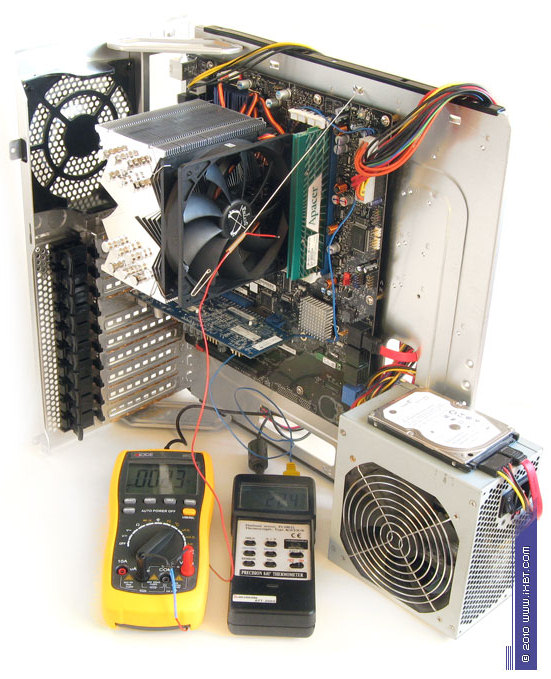Thermaltake Jing CPU Cooler
|
Tests
Testbed:
- Intel Xeon X3450 CPU
- Intel DP55KG motherboard
- Microsoft Windows 7
- Digital thermometer Aktakom ATT-2002 with a calibrated K-type thermocouple integrated into processor cover
- Victor VC86C multimeter with a calibrated K-type thermocouple
- Noctua NT-H1 thermal compound
Definitions:
- Noiseless — cooler is passive.
- Almost noiseless — below 24 dBA. Quieter than a typical quiet room (in the evening or at night). Cooler barely adds to the noise of a passively cooled PC equipped with noise-reducing hard drive enclosures and such.
- Low noise — 24 dBA to 30 dBA. Cooler barely adds to the noise of a PC where every other cooler is quiet.
- Average noise — 31 dBA to 36 dBA. Cooler barely adds to the noise of a typical PC, but makes audible noise in a quiet PC.
- Loud noise — 37 dBA to 42 dBA. Cooler makes audible noise in most typical PCs except those equipped with 10,000-rpm hard drives, high-speed coolers and such.
- Very loud noise — over 42 dBA. Cooler is the primary source of noise in any PC. Not recommended for home use.
Briefly, the testing procedure is as follows. The tested cooler is mounted on the CPU according to the supplied user's guide. Then it's heated up in three 30-minute sessions by means of a special S&M tool. During those we measure CPU temperatures (and monitor ambient temperature).
We tested the cooler under high heat load: 3.81GHz processor clock rate, VCC = 1.4125V, VTT = 1.2V, heat power emitted through CPU cover is 185W, the full power is about 210W.
CPU temperature, lowest possible noise
Thermal resistance, lowest possible noise
Thermaltake Jing demonstrates interesting results. It performs on a par with the higher-end Frio, sometimes losing a bit in the configuration with two fans (500 and 300 rpm). In other words, Jing is almost as suited for low-noise rigs as Frio is, even despite the lighter build. However, you should note that with almost every cooler (except maybe Noctua NH-D14) the CPU temperature goes outside the safe range. So if actual heat load is about 180-190 watts, you will either have to increase fan speed up to 700 rpm or choose another cooler.
CPU temperature, almost noiseless (<24 dBA)
Thermal resistance, almost noiseless (<24 dBA)
Thermaltake Jing performs on a par with the best in class: GlacialTech Alaska, Thermaltake Frio and Scythe Mugen 2. The lag behind the champtions Noctua NH-D14 and Thermalright IFX-14 is minor. This mode seems the best for Jing, all the more so because the CPU temperature drops below 70°C, a kind of safe-zone threshold for a dual-fan setup.
Next, let's see how Jing performs at a higher fan speed and how it competes against solutions like Cooler Master Hyper 212 Plus, Ice Hammer IH-4350B and Thermaltake Contac 29.
Write a comment below. No registration needed!
|
|
 |
|
|
|

